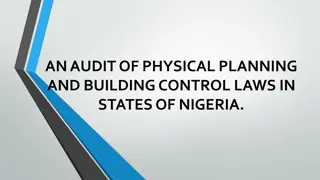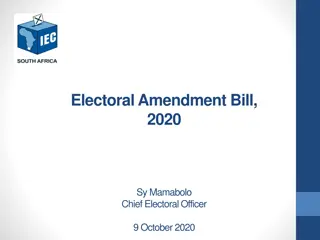The Journey of a Bill: How Laws are Made
Discover the fascinating journey of a bill becoming a law in the U.S. Congress. From its introduction to committee assignments, floor debates, Senate review, and final voting, explore the detailed process step by step with insights and visuals.
Download Presentation

Please find below an Image/Link to download the presentation.
The content on the website is provided AS IS for your information and personal use only. It may not be sold, licensed, or shared on other websites without obtaining consent from the author.If you encounter any issues during the download, it is possible that the publisher has removed the file from their server.
You are allowed to download the files provided on this website for personal or commercial use, subject to the condition that they are used lawfully. All files are the property of their respective owners.
The content on the website is provided AS IS for your information and personal use only. It may not be sold, licensed, or shared on other websites without obtaining consent from the author.
E N D
Presentation Transcript
How a Bill Becomes a Law The Journey of a Bill
Congress Makes Federal Laws Follow the bill as it moves through Congress
Introduction of the Bill The bill can come from a variety of sources: Individual citizens, Special interest groups Corporations, Non-governmental organizations (NGOs) Only a member of Congress can introduce the bill A bill can start in either House, except revenue bills-Must start in the House of Representatives.
The Bill is Assigned to Committee Each House has standing committees that consider their bills. Each committee has a chair (from the Majority) and a ranking member (from the minority). They mark-up (edit) the bill so it will pass on the floor. They can also pigeonhole or kill the bill in committee. The bill must also pass through the House Rules Committee.
The Bill is Reported To the Floor If the bill is passed by the committee, it is sent to the whole House for debate and vote. The committee has reported the bill favorably to the floor. The Speaker determines which bills are discussed and for how long. Committee chairs and ranking members give out time to debate to other members.
The Bill is Debated and Voted On in the House Bills can be considered by the whole House at once: called Committee of the Whole Votes are done electronically in the House. This is a role call vote. A tote board on the wall shows the tally. Red = oppose. Green = Agree Yellow = Abstain Votes can be taken by voice yeas and nays or a teller vote where members file past the sergeant at arms.
The Bill Goes to the Senate The bill is sent to the US Senate. A Senate version is written with the letter S. and a number. House bills have HR. As in the House, the bill must be referred to the appropriate standing committee. Committees hold hearings and make changes to the bill. The committee can report the bill to the Senate floor.
The Bill is Debated and Voted On in the Senate The Senate Majority Leader determines which bills are scheduled, when and for how long. As in the House, the bill must be referred to the appropriate standing committee. Debate in the Senate is unlimited. Filibusters can be used by the minority to block bills. 3/5 (60) of the Senate must agree to end debate (this is called cloture ) The Senate Rules committee is much weaker than the House s.
Both Houses Must Pass the Bill A simple majority in both houses is needed to pass the bill (51%). In the House: 218 needed to control the House. In the Senate: 51 senators needed to pass the bill (and control the Senate).
Differences Between Houses Must Be Reconciled Each house passes its own bill. Any differences must be ironed out and made into one bill. The bill is considered by a conference committee, made up of both House and Senate members. They negotiate and compromise and send the combined bill back to both houses. A vote on the conference report must be taken and passed by both Houses.
The Bill is Sent to the President The president can sign the bill if he wants it to become law. He can include signing statements that say how the law should be enforced or if parts will not be enforced. The president can veto or reject the bill. He must include his reasons and recommendations for correction. The president can choose not to act on the bill. If Congress is in session, the bill becomes law after 10 days. If Congress is not in session, the bill dies after 10 days. This is called a pocket veto.
The Bill Becomes Law If the president vetoes the bill, both Houses can reconsider the bill. Two-thirds (67%) of both Houses are needed to override the President s veto. In the House: 369 needed for override. Senate: 67. If president signs the bill, it is a federal law that each state must follow.























